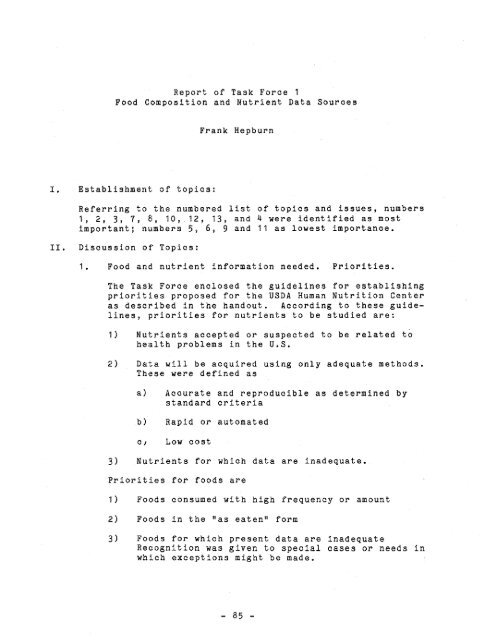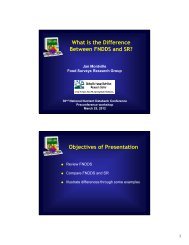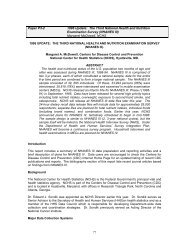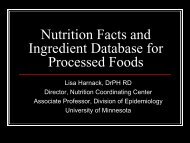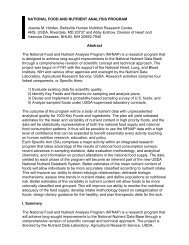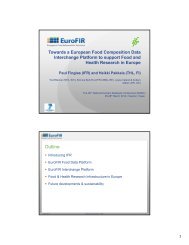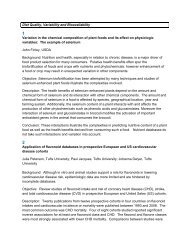Food Composition and Nutrient Data Sources
Food Composition and Nutrient Data Sources
Food Composition and Nutrient Data Sources
Create successful ePaper yourself
Turn your PDF publications into a flip-book with our unique Google optimized e-Paper software.
<strong>Food</strong><br />
Report of Task Force 1<br />
<strong>Composition</strong> <strong>and</strong> <strong>Nutrient</strong> <strong>Data</strong> <strong>Sources</strong><br />
Frank Hepburn<br />
I. Establishment of topics:<br />
Referring to the numbered list of topics <strong>and</strong> issues, numbers<br />
1, 2, 3, 7, 8, 10, 12, 13, <strong>and</strong> 4 were identified as most<br />
important; numbers 5, 6, 9 <strong>and</strong> 11 as lowest importance.<br />
II.<br />
Discussion of Topics:<br />
1. <strong>Food</strong> <strong>and</strong> nutrient information needed. Priorities.<br />
The Task Force enclosed the gUidelines for establishing<br />
priorities proposed for the USDA Human Nutrition Center<br />
as described in the h<strong>and</strong>out. According to these guidelines,<br />
priorities for nutrients to be studied are:<br />
1) <strong>Nutrient</strong>s accepted or suspected to be related to<br />
health problems in the U.S.<br />
2) <strong>Data</strong> will be acquired using only adequate methods.<br />
These were defined as<br />
a) Accurate <strong>and</strong> reproducible as determined by<br />
st<strong>and</strong>ard criteria<br />
b) Rapid or automated<br />
c, Low cost<br />
3) <strong>Nutrient</strong>s for which data are inadequate.<br />
Priorities for foods are<br />
1) <strong>Food</strong>s consumed with high frequency or amount<br />
2) <strong>Food</strong>s in the "as eaten" form<br />
3) <strong>Food</strong>s for which present data are inadequate<br />
Recognition was given to special cases or needs in<br />
which exceptions might be made.<br />
- 85 -
2. Availability <strong>and</strong> usability of USDA <strong>Data</strong> Base II.<br />
USDA Representatives agreed to making <strong>Data</strong> Base II<br />
available but the usability was questioned. Because<br />
DBII is a summary of identical qualifiers. subgeneric<br />
comparisons might be made but they would have doubtful<br />
meaning.<br />
3. How to report values for nutrients which bave low<br />
priority for analysis<br />
<strong>Food</strong>s likely to be very low in nutrients should be<br />
recorded as "zero W rather than "unknown". The probable<br />
(as opposed to possible) value should be adopted.<br />
Imputed values can be made by a committee of experts or<br />
by individual judgment but when no basis for decision<br />
is available the value could be described as unknown.<br />
7. Conversion of Common measures; identification of common<br />
measure-weight equivalents.<br />
Concensus was that there is a need to share information<br />
about values used but not necessary to adopt a single<br />
st<strong>and</strong>ard. Observed that values may be determined by<br />
particular purpose of individual excercise or operating<br />
group.<br />
8. Non-nutrient substances.<br />
Information on tbese substances pertain to special purpose<br />
applications. When added to a data base f they<br />
should be coded <strong>and</strong> h<strong>and</strong>led as a nutrient.<br />
10. Identification of br<strong>and</strong> name products by USDA.<br />
There is no rule against br<strong>and</strong> names; except endorsement.<br />
Br<strong>and</strong> names will be used for breakfast cereals.<br />
However some manufacturers have submitted data<br />
anonymously by code <strong>and</strong> the identity may be unknown.<br />
12. Vitamin <strong>and</strong> mineral supplement data.<br />
Users expressed need for data in evaluating nutrient<br />
intakes.<br />
13. Use of nutrition labeling data.<br />
Agreed that label claim data should not be included in<br />
the data base because of under-estimation inherent in<br />
labeling l~egulations. However, the laboratory analytical<br />
bases for calculating label values are highly<br />
desired.<br />
4. Evaluation <strong>and</strong> comparison of data in nutrient data<br />
bases.<br />
Agreed that this should be done to:<br />
a) Verify equality of sample identification<br />
- 86 -
) Compa~e equivalence of quantity<br />
5. Establishment of a common bi~liog~aphy.<br />
Ag~eed that sou~ce of data should be identified in unifo~m<br />
manne~.<br />
6. Establishment of common conventions.<br />
(Topic left to one of othe~ Task Fo~ces)<br />
9. Cent~al collection of data f~om food indust~y.<br />
Doubtful that a~~angement would be accepted by indust~y<br />
o~ desired by users because information need varies<br />
with individual pu~pose.<br />
11. Canadian -- American cooperation.<br />
Cooperation would be welcome but oppo~tunities unknown.<br />
- 87 -


